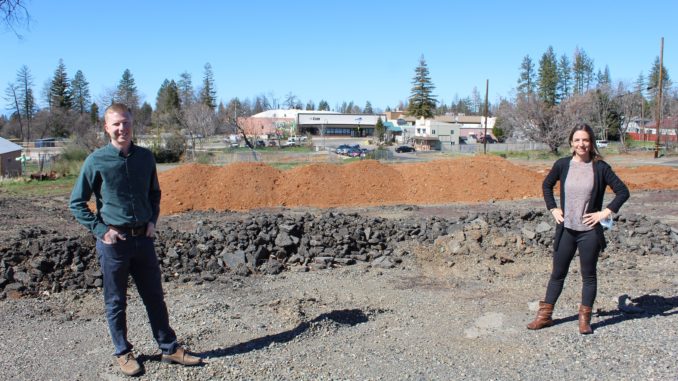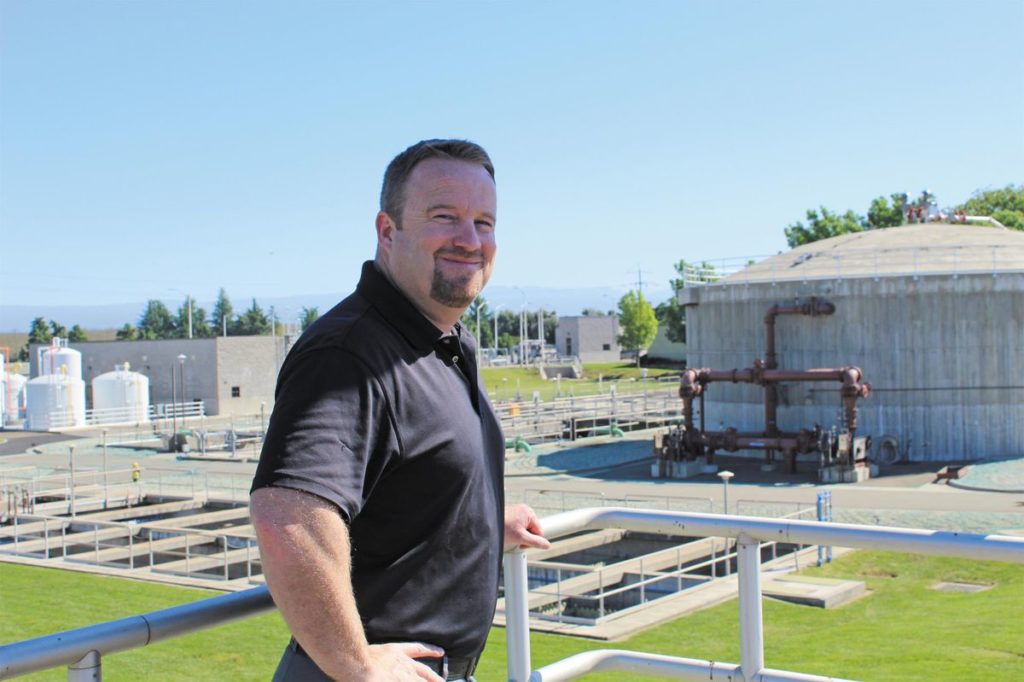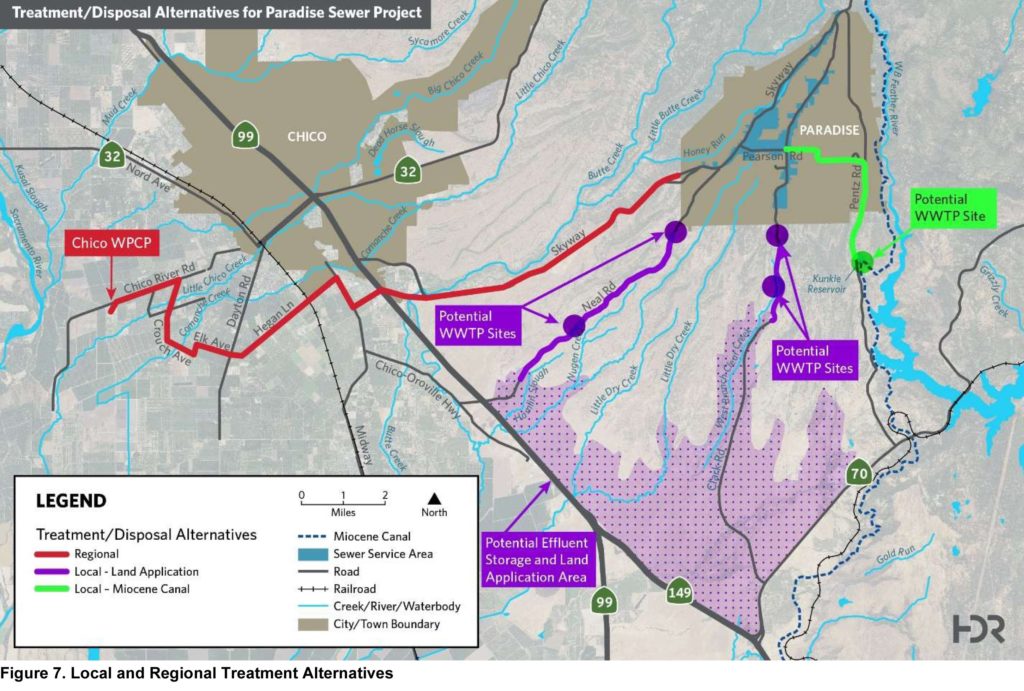
On a recent afternoon, Marc Mattox and Katie Simmons had a clear view of downtown Paradise from where they stood on Almond Street near an empty lot razed in the 2018 Camp Fire.
The road, which runs parallel to the Skyway, was often a popular route during community events, as it is a straight shot to Terry Ashe Recreation Center, the site of gatherings such as Johnny Appleseed Days and Gold Nugget Days.
Nowadays, the street is quiet and desolate. This part of town is emblematic of the area that would be impacted by a hefty proposal that Mattox, Paradise’s Public Works director and town engineer, and Simmons, the town’s disaster recovery director, say is key for recovery and bringing people back to the Ridge.
This street would become part of the proposed Paradise Sewer Service Area. The town has re-entered discussions with the city of Chico to explore a project that would install an 18-mile-long pipe running from Paradise through Butte County land to Chico’s Water Pollution Control Plant.
Such a pipeline has been discussed for years, as waste disposal has long been an issue for the town. Paradise runs entirely on individual septic systems, many of which were failing before the fire and continue to be cost prohibitive for commercial and multi-family endeavors. Various sewer project proposals have been nixed by town voters and their elected officials over decades.
The Paradise Sewer Project would pave the way for the empty lots on Almond and other streets to become sites of apartments, businesses or homes connected to the town’s first sewer service, Mattox and Simmons told the CN&R.
“It seems like something we can’t live without to build back Paradise and to build out the vision that the community members really have for this community,” Simmons said. “This is as critical to our recovery as the basics of debris removal and tree removal.”
Mattox concurred, adding that “the Camp Fire is the impetus for the now-or-never question.”
However, the project has garnered critiques from the public and local elected officials, particularly in regards to environmental, fiscal and quality-of-life impacts. Opponents argue that there are more sustainable ways to support the recovery of Paradise and ensure that unchecked growth along the pipeline’s corridor doesn’t dramatically alter life in Butte County. In addition, some argue that the process hasn’t been transparent and are concerned that only one option, a substantial regional project, is being presented as the path forward.
What’s it all about?
Initial estimates hover around $180 million to design and construct an 18-mile pipe that would flow from the town alongside the Skyway Corridor and connect to the Chico wastewater facility.
Paradise ratepayers within the sewer area would cover their portion of system fees and maintenance costs. As to how much they’d have to pay, that’s still to be determined.
The town maintains that it will seek grant and state/federal funding to pay for the project and that it will not burden Chico taxpayers. (As for $219 million in PG&E settlement funds, the town currently is drafting a plan with long-term revenue and recovery in mind.) The preliminary pre-environmental analysis by global firm HDR Engineering has been paid for through grants—$800,000 from the state and $172,000 from the U.S. Department of Agriculture.
The town wants to hook up just a fraction of the lots in Paradise to the sewer system. It would serve 1,469 parcels (out of 11,000 total), all located along the busiest thoroughfares: Skyway, Clark Road and Pearson Road. There are approximately 300 standing homes in this area. The HDR study estimates there will be 357 occupied parcels by 2027, when the system would be completely installed, and that it could take 30 years before all 1,469 are in use.
While the project, at this point, has received unanimous approval to be explored by both the Paradise Town Council (aside from a recusal from Councilman Greg Bolin) and the Chico City Council, some members have already voiced concerns about impacts to their constituents.
At a City Council meeting on Feb. 2, Mayor Andrew Coolidge said that “zero negative environmental impacts for the city of Chico” and “negative cost/no increased costs to our ratepayers would be necessary for us to move forward on this.”
Similarly, Paradise Town Councilwoman Rose Tryon said at a Dec. 8, 2020, meeting that the town needs to protect Paradise ratepayers from subsidizing Chico and ensure that the partnership does not limit the town’s ability to grow.
Mattox replied that those answers will all be revealed through the project planning process. The pipeline proposal will be examined by the Paradise Sewer Regionalization Project Advisory Committee, a Chico-Paradise body formed and facilitated by the state’s Central Valley Regional Water Quality Control Board (see note at end of story). The board sent a letter of support to the town for the regional concept in November. HDR Engineering is preparing the project environmental impact report (EIR), which likely won’t be complete until mid-to-late 2022. It is funded by $2 million from the State Water Board Division of Financial Assistance.
The city of Chico has a vested interest into at least looking into the project, which could open its treatment plant up for grant funding for improvements, according to city staff. The plant’s employee work load, demand for supplies, electricity and maintenance costs have all increased since the Camp Fire, when refugees settled in Chico. City Public Works Director for Operations and Maintenance Erik Gustafson told the CN&R that flows are still up 5 percent to 6 percent, or 400,000 gallons to 500,000 gallons more per day, from pre-Camp Fire flows of 5.98 million gallons per day.

In addition to support from the Central Valley Regional Water Quality Control Board, the Paradise Sewer Project concept also has the backing of Assemblyman James Gallagher. He has proposed a state bill (AB-36) to expedite the process not only for the town’s sewer project but the Paradise Irrigation District’s controversial intertie proposal that could transfer fresh water to Chico (a project that is in the study stages), waiving the requirement for competitive bidding if the projects move forward.
“These projects do not allow for any new growth outside of the Town of Paradise. Projects that are already planned in Chico do not need this water or sewer project. Paradise is simply trying to recover and become more resilient,” Gallagher wrote in a Facebook post.
What are the concerns?
Those who take issue with the project urge the town to consider local, decentralized options that, long-term, they argue, would be more sustainable and have less environmental impact.
For Mark Stemen, the vice chairman of Chico’s Climate Action Commission, the pipe is a monstrous project that will pave the way for urban sprawl along the Skyway if it moves forward.
“People think, ‘Oh it’s just a road’ or ‘It’s just a pipe.’ But it isn’t. It’s a conduit for changing the land around it,” Stemen told the CN&R.
In Stemen’s view, the best option for Paradise’s recovery is one that keeps its wastewater treatment and discharge localized, and doesn’t dramatically increase the county’s greenhouse gas production, accelerating the devastating impacts of climate change.
The town has maintained that the pipeline to Chico is the cheapest option, but “climate change doesn’t pencil out either,” Stemen said. “It was climate change that burned Paradise. We don’t need to keep doing this. We have to do something different.”
For Butte County Supervisor Debra Lucero, the process has not been transparent and has not taken all key partners, such as the county, into account in the planning process. Butte County is not part of the Paradise Sewer Regionalization Project Advisory Committee, despite the fact that the pipeline would run through miles of county land. That has fiscal and environmental implications, she said.
“I’m concerned that Chico citizens have not had an opportunity to attend workshops and learn more about what this route will look like,” she said. “I just think there are a lot of unanswered questions. … What I’m being told is the EIR is supposed to be for that purpose. But to get to an EIR phase without public discussion? There’s something wrong with the process.”
Lucero said that, ideally, the county needs to be more involved and the public needs to be informed and engaged in a process that must consider alternatives, not just a pipeline to Chico.
“Is it the best idea to spend $180 million and build a behemoth infrastructure that’s going to take five or six years to build, or might our region be better served by decentralized [wastewater treatment] systems?” she said. “I’m worried about the unintended consequences of a project this size. … If we aren’t intending to grow Chico into San Jose, why are we doing this?”
Are there other options?
In an analysis prepared by HDR Engineering, the Chico pipeline project is presented as the most attractive. Mattox referenced the report and community concerns during a recent conversation with the CN&R.

The HDR team concluded that the pipeline to Chico was the top contender, followed by finding land to create a local treatment plant for Paradise. The study looked at economic impacts (the cost), implementation (how easy it would be to get the project off the ground, including political approvals and cooperation from local landowners), environmental impacts (to water quality, air quality and watersheds with a goal of maintaining ag land and finding the quickest permitting process), social impacts of installation and maintenance, and operational impacts (including regulatory requirements and system technical complexity and capacity).
The local treatment option would have the town seeking nearly 500 acres to operate a plant, Mattox said, which would have to be located in the Neal or Clark Road corridors outside town limits due to Paradise’s topography and poor soils.
“One, that land isn’t just readily available, and two, the environmental impact on that land would be immense,” he said. “You’re taking away potential ag use and reserve open space for a wastewater treatment plant and the management of those types of volumes of treated wastewater to store, because there’s no Sacramento River nearby to discharge to.”
The proposed project will only examine the impacts of hooking up parcels within the town limits to the city’s wastewater treatment plant, Mattox added. Any future development or growth of the sewer service area would require its own public analysis and review, he said. The Paradise-Chico pipeline’s environmental impact review process will take 18 months, giving the public and policymakers ample time, he said.
“We’ve gone through our due diligence … those processes were completed and those findings and methodology are all publicly available on our websites,” Mattox said. “Like many recovery projects, we are moving forward boldly to explore this through the [California Environmental Quality Act]/EIR process to see if it will work. The truth is it may not, and we believe Paradise’s recovery depends on it.”
Weigh in:
Paradise and Chico are part of the Paradise Sewer Regionalization Project Advisory Committee. Meetings are broadcast virtually to the public. Go to paradisesewer.com for info on meetings and opportunities for public participation.

Be the first to comment